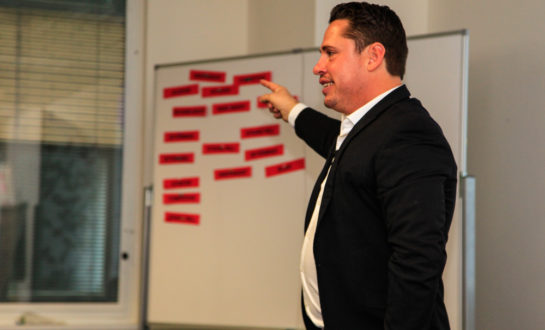

Strategies to Improve Public Speaking
I have dedicated my life to creating powerful and proven structures that other people can easily apply to their life or situation for amazing results. It’s my passion to help people discover and reach their personal goals.
One of the structures I have created is around successful strategies people can use to improve public speaking.
Using fast and effective neuro linguistic programming techniques we uncover the autopilot responses hidden deep in your unconscious mind, then bring them to your awareness for you to reassess. It’s really fast, completely painless and it really works.
We look at all the ways we communicate bother verbally and non-verbally and teach you how to work with the natural communication methods already with you to address an audience. We teach you to reset your mind set to automatic positive thinking that will give you the confidence and motivation to keep moving forwards.
Here are tips to structure a presentation that people will pay attention to.
1. Know what you are talking about
The best speakers know their subject matter inside out and back the front. They speak about things they live and breathe or that they have created. Because they know it so well they don’t need to think so much about what to say.
They know the subject matter, the words just flow, and they have unlimited examples to draw on. Be sure to know what you are talking about. Speakers address by a subject, not by notes. That way all your concentration can be on who you are talking to. This gives you space and time to pay attention to your body language, your tone of voice, how fast you are speaking and how well your message is being received and will enable you to be light on your toes come question time.
Spend time preparing a powerful opening. Something unexpected and true for you. What is going to grab people’s attention and have them on the edge of their seat?
Know how long you want it to go and be sure to wrap up the points you made along the way and be prepared as far in advance as possible. As soon as you get notice, start constructing.
2. Be relevant
Make sure the audience you are addressing wants this information. It is essential that it is relevant to them, not just the information, but also the way you deliver it, the jokes, the speed, the detail and the sophistication all need to match your audience.
Before you start check over and make sure the material you have is engaging and will have a positive impact.
Do your research and know who you are talking to. Target functions or events that have a ready and willing audience for your subject matter.
Have some metaphors up your sleeve!
A metaphor is a great way to illustrate a struggle and solution that your audience can step into. Giving your audience space to step into what you are saying will make it relevant to them. Think of the movies you watch. Movies, especially from Disney, have great metaphors that you can reference easily.
3. Practice
To be good at anything you need to practice, notice where improvements can be made and practice again. Everything you do is practice; saying your speech aloud to yourself, videoing yourself and watching playbacks, asking your friends or colleagues to step in as a practice audience or standing at an actual event and presenting for real, it’s all practice. Be sure to always look for constructive feedback and making the changes you need.
To be a true professional in any area you need to have completed 10,000 hours practice, so make sure you put as many hours as you can in. It all counts.
4. Be present
Stay in the moment. That means no notes. Reading off a page distracts you from the people in front of you and limits your ability to tweak your delivery to their needs. Stand tall, be aware of your audience and let your presentation flow. There are plenty of great mindfulness manuals to read if you need help or tips on how to get present. If you are struggling to get present, and your mind is going back to past hurts or forward to worst case scenario, download my free Belief Buster guided meditation and use it before any presentation.
5. Know what your body language is saying
Nonverbal communication makes up a giant proportion of what we say. Most of the time it is without direction. Learn how to use non-verbal communication as part of your presentation. There are different strategies depending on the environment, a boardroom versus a theatre hall for example.
Show confidence, openness and authority in your stance. Be careful not to fidget or wave your arms around unnecessarily causing distraction or confusion.
The best thing you can do for a great presentation is to keep breathing. So many people get so nervous they forget to breathe!
Focus on your breath (which is also great for mindfulness) and keep an open stance.
Maintain eye contact or let your eyes drift steadily over your audience’s foreheads (which appears to be eye contact without rattling you while you are starting out).
Walking slowly can really emphasise a metaphor and also keep your audience attentive. Pacing, however, will make your audience giddy and restless.
The best way to see your body language habits is to record your presentation (practice ones and real) and watch yourself with a gentle and constructive eye.
6. Have a goal
Have an outcome in mind. Know what you are doing your presentation for and keep working towards his outcome.
This gives you a positive that will outweigh the fear and help you stay focused.
Visualise your goal, know what you will Hear see and feel at the completion of this goal.
7. Get anchored
Just like an anchor of a ship holds a boat steady so it doesn’t drift, presentation anchors are there to keep you in the state you desire to be in.
Firstly load up an emotional anchor with whatever positives you need when you perform. It might be confidence, calmness, enthusiasm, energy, courage. Whatever your needs are get them set in and use them whenever you can. Just make sure they are subtle.
You second anchor is a person or people who you trust. Have them sit on the edge of your vision and know they are there if you need a smile, a nod of encouragement or a thumbs up.
Being a presenter and having confidence in myself in front of people has been the biggest gift. I am so grateful for the opportunity to positively influence people and change lives through the information I give and my courage to give it.
You have something worth sharing with the world. I hope to see you transform that potential into reality very soon, and if you would like help with public speaking, please register for my course Influence Now and we will have you sharing your message with the masses in no time.
Kindest regards,
Matt Catling






